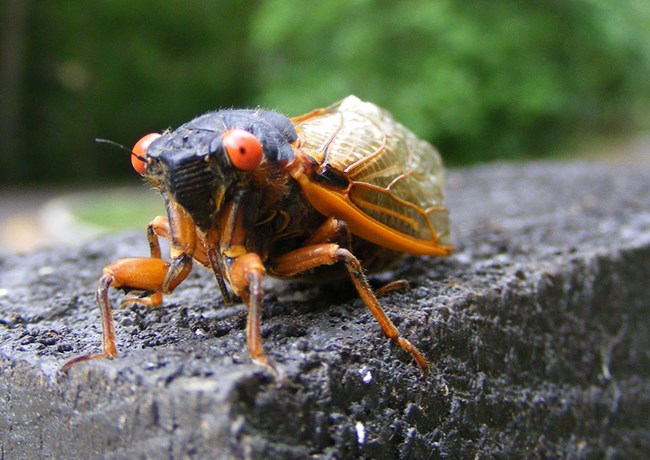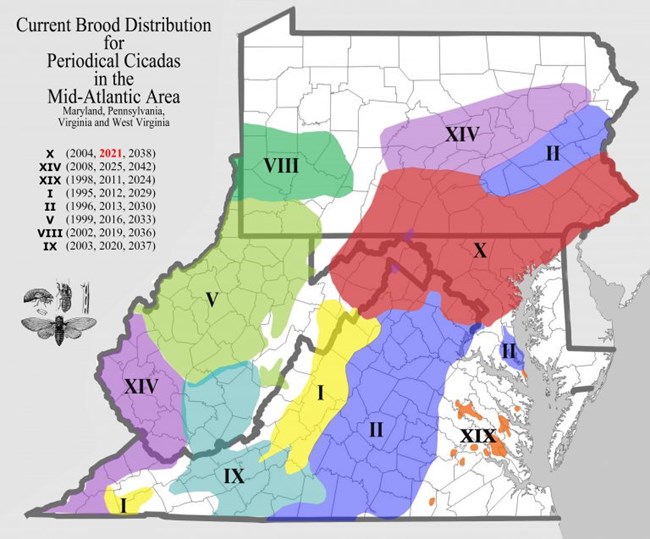Article
Brood X Periodical Cicadas FAQ

NPS/Nortrup
What are cicadas and specifically Brood X?
- Periodical cicadas are insects that belong to the order Hemiptera (true bugs). They feed on plant fluids (xylem) both below and above ground.
- Brood X (X is 10 in Roman numerals) is the largest brood of 17-year cicadas. This brood is found in three separate areas centering around Pennsylvania and northern Virginia, Indiana, and eastern Tennessee. The largest emergence of Brood X appears as adults only once every 17 years.
- There are 7 species of periodical cicadas, one was recently described. There are 3 species in the Washington, DC area. There are also annual cicada species (that are green) that come out every year.

Cicadas.Info
When are they expected to arrive?
- The time frame for 2021 arrival is weather dependent - when ground temperatures reach 64 degrees. The periodical cicadas are predicted to begin the first or second week of May and will be gone by the end of June. (Annual cicadas will be out in June - August.)
Why do they do they come out in large numbers every 17 years?
-
By coming out in huge numbers, all the predators that eat cicadas can get their fill and there will still be plenty of cicadas left to breed and perpetuate the species. It’s a survival strategy call prey satiation. There are more cicadas than all the combined predators can eat.
- Common predators in our area are birds, racoons, opossums, foxes, mice, shrews, frogs, toads, turtles, fish, and a fungus called massospora.
What is the lifecycle of Brood X?
-
Cicada nymphs go through 5 stages of development (instars) during 17 years underground. When they become adults, males come out first to begin mating. The females will then lay about 500 eggs. They rise for about one month and will die after mating. Eggs are laid in trees, and when they hatch about six weeks after they are laid, tiny nymphs will drop to the ground. These small nymphs will then burrow into the ground and disappear for another 17 years.
- Periodical cicadas generally live underground for 17 years, however there are much smaller numbers that come out after 13 years and some that come out after 21 years. These "stragglers" are the result of the underground nymphs growing at different rates.
How do they impact the environment? (i.e. should I avoid planting certain things?)
-
The massive number of periodical cicadas emerging can harm young trees because the females lay their eggs in young tree branches. Spring 2021 is not a good time to plant small trees. Fall is a good time to plant trees this year or spring plantings can be protected with netting.
-
Many animals from frogs to fish and raccoons to birds eat cicadas and the emergence of brood X is a grand feast for the animal world. Studies have shown that some birds have larger clutch sizes during the years periodical cicadas emerge. The adult cicadas die soon after mating and fertilize the soil near the trees where their nymphs will feed and grow.
- There are currently 12 broods of 17-year cicadas and 3 broods of 13-year cicadas. The 13-year cicadas are not found near D.C. Two broods have gone extinct (one near Connecticut and one in Florida). The broods have migrated northward since the last ice age.
How do they make their signature sound, and does it mean anything?
-
Only males "sing." They use an organ called the tympanic membrane which is located on both sides of the body near the base of the wing. The vibrations from this organ make their sound.
-
Males come out first and call to attract females. Females indicate willingness to mate by making a clicking sound with their wings.
-
Each species has a different "song." They are often heard singing together, creating a harmony of the three songs blended together.
- Male cicadas produce the loudest sounds in the insect world. Entomologists believe that the sound protects these insects by hurting predators' ears.
Are they invasive?
- Periodical cicadas are a native species.
Are they safe to be around?
-
Yes, they don’t bite or sting.
- They are not toxic to pets in small amounts.
- If you have a shellfish allergy, you may have a cicada allergy if you eat them.
What do they eat?
- Below ground, nymphs eat xylem (sap) in tree rootlets.
Do cicadas really have blue eyes?
They vast majority have orangish red eyes. A few mutants can have blue or white eyes, though this is uncommon. Cicadas have five eyes - two large red ones with three small, dark colored eyes in between.
What can I do?
- Enjoy watching the cicadas while they're here.
- Do not use insecticides since they will not control populations and may hurt other beneficial insects.
- Add cicadas carcasses to your compost.
- Use the Cicada Safari app to help scientists track Brood X.
Tags
- anacostia park
- antietam national battlefield
- arlington house, the robert e. lee memorial
- baltimore-washington parkway
- catoctin mountain park
- chesapeake & ohio canal national historical park
- fort dupont park
- fort foote park
- fort washington park
- george washington memorial parkway
- glen echo park
- great falls park
- greenbelt park
- harpers ferry national historical park
- hopewell furnace national historic site
- kenilworth park & aquatic gardens
- manassas national battlefield park
- monocacy national battlefield
- national capital parks-east
- national mall and memorial parks
- oxon cove park & oxon hill farm
- piscataway park
- prince william forest park
- rock creek park
- theodore roosevelt island
- valley forge national historical park
- nature
- entomology
- bugs
- phenology
- natural sounds
- natural resource quarterly
- summer 2021
